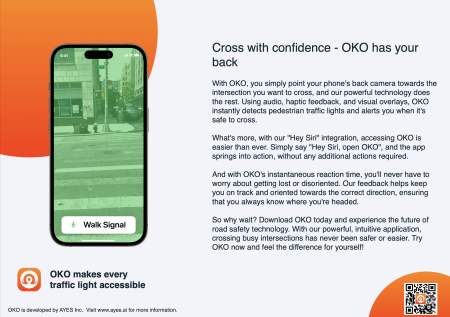Our members are dedicated to improving road safety and sharing their knowledge with the wider community. Here, you can explore our members' good practices – initiatives that have been assessed for their effectiveness in addressing a road safety problem and have proven results.
Get inspired – and sign up to share your good practices too!

Thursday, May 25, 2023
Individuals who are blind or have low vision face unique challenges when it comes to navigating our roads. These challenges include not being able to access traditional signage and visual warning signals, not being able to make eye contact with drivers and other road users, veering on crossings or collision with obstacles due to an absence of visual information. The NCBI conducted research and found that 63% of individuals with a vision impairment reported being injured in a public place at least once when navigating outdoors and 59% indicated increases in micro mobility and changes in public space reduced their confidence to walk and access the community. Research also highlighted that despite not having legislation for e-scooters in Ireland, 64.9% of individuals with a vision impairment had experienced a near miss with an E-Scooter on Irish roads.

Wednesday, May 24, 2023
Desde su constitución en el año 2016, Netun Solutions centra su actividad en el desarrollo de soluciones tecnológicas orientadas a la mejora de la seguridad vial en las carreteras de todo el mundo.
El principal reto al que ha dedicado sus esfuerzos es la reducción de las víctimas de atropello, así como la mejora en los tiempos y calidad de la asistencia en situaciones de auxilio vial.
Se detecta que la parada de un vehículo en la vía debido a una emergencia, los operarios ejerciendo trabajos de mantenimiento, los usuarios vulnerables (ciclistas) y los vehículos lentos constituyen un riesgo para la circulación. Los tradicionales sistemas de señalización no ofrecen una protección adecuada, sobre todo en condiciones de baja visibilidad debido a la falta de percepción real efectiva de los vehículos cuando quedan parados en la vía, lo que puede derivar en nuevos accidentes. Además, carecen de sistemas de geolocalización que puedan determinar y comunicar la situación del obstáculo.
Según las propias palabras de Pere Navarro, Director de la Dirección General de Tráfico española (DGT), “Un 20% de las muertes en autopistas y autovías se produjo por atropello a gente que bajó del vehículo o que estaba trabajando”.
Si bien las cifras de atropellos en las carreteras españolas son difíciles de clasificar, una aproximación realizada por el Centro de Estudios Ponle Freno-AXA indica que el 50% de los fallecidos por atropello lo son durante las maniobras de señalización posteriores a una parada. Sin ir más lejos el balance de siniestralidad vial de 2022 publicado recientemente por el Ministerio del Interior español recoge que de los 126 peatones fallecidos la mitad fueron en autopistas y autovías (58) y más de 3 de cada 10 fallecidos en estas vías rápidas lo fueron cuando se habían bajado del vehículo.
Otros estudios hablan de más de un centenar de personas fallecidas en España mientras trabajan en la carretera, de ellas la mitad eran operarios de conservación y mantenimiento de las mismas.
Hasta 2021, los sistemas actuales de señalización eran ineficientes, no anteponían la seguridad de los ocupantes al vehículo, no daban soluciones eficaces a usuarios vulnerables como los operarios de la vía ni se aprovechaban las nuevas tecnologías disponibles para solventar esta situación.
Con todo ello, el principal reto de Netun Solutions ha sido el diseño de una solución universal que permita la señalización y/o geolocalización inmediata de los agentes de la vía y su distribución a las autoridades de tráfico y otros agentes implicados.
Para hacer frente a este nuevo desafío se ha desarrollado en Netun Solutions un portfolio de productos capaces de conectarse a DGT 3.0, la plataforma española de movilidad inteligente, entre ellos, cabe destacar:
Help Flash IoT: primera baliza V16 conectada a través de tecnología NB-IoT.
Dispositivo V2 conectado: baliza profesional geolocalizada para vehículos lentos y de transporte especial.
Dispositivo de geolocalización personal individual. Geolocaliza a los operarios de conservación mientras hacen sus labores de mantenimiento en la vía.
Cono inteligente: cono geolocalizado que indica la posición de un tramo en obras, mantenimiento o cortado al tráfico por una prueba deportiva en curso.
El principal reto al que ha dedicado sus esfuerzos es la reducción de las víctimas de atropello, así como la mejora en los tiempos y calidad de la asistencia en situaciones de auxilio vial.
Se detecta que la parada de un vehículo en la vía debido a una emergencia, los operarios ejerciendo trabajos de mantenimiento, los usuarios vulnerables (ciclistas) y los vehículos lentos constituyen un riesgo para la circulación. Los tradicionales sistemas de señalización no ofrecen una protección adecuada, sobre todo en condiciones de baja visibilidad debido a la falta de percepción real efectiva de los vehículos cuando quedan parados en la vía, lo que puede derivar en nuevos accidentes. Además, carecen de sistemas de geolocalización que puedan determinar y comunicar la situación del obstáculo.
Según las propias palabras de Pere Navarro, Director de la Dirección General de Tráfico española (DGT), “Un 20% de las muertes en autopistas y autovías se produjo por atropello a gente que bajó del vehículo o que estaba trabajando”.
Si bien las cifras de atropellos en las carreteras españolas son difíciles de clasificar, una aproximación realizada por el Centro de Estudios Ponle Freno-AXA indica que el 50% de los fallecidos por atropello lo son durante las maniobras de señalización posteriores a una parada. Sin ir más lejos el balance de siniestralidad vial de 2022 publicado recientemente por el Ministerio del Interior español recoge que de los 126 peatones fallecidos la mitad fueron en autopistas y autovías (58) y más de 3 de cada 10 fallecidos en estas vías rápidas lo fueron cuando se habían bajado del vehículo.
Otros estudios hablan de más de un centenar de personas fallecidas en España mientras trabajan en la carretera, de ellas la mitad eran operarios de conservación y mantenimiento de las mismas.
Hasta 2021, los sistemas actuales de señalización eran ineficientes, no anteponían la seguridad de los ocupantes al vehículo, no daban soluciones eficaces a usuarios vulnerables como los operarios de la vía ni se aprovechaban las nuevas tecnologías disponibles para solventar esta situación.
Con todo ello, el principal reto de Netun Solutions ha sido el diseño de una solución universal que permita la señalización y/o geolocalización inmediata de los agentes de la vía y su distribución a las autoridades de tráfico y otros agentes implicados.
Para hacer frente a este nuevo desafío se ha desarrollado en Netun Solutions un portfolio de productos capaces de conectarse a DGT 3.0, la plataforma española de movilidad inteligente, entre ellos, cabe destacar:
Help Flash IoT: primera baliza V16 conectada a través de tecnología NB-IoT.
Dispositivo V2 conectado: baliza profesional geolocalizada para vehículos lentos y de transporte especial.
Dispositivo de geolocalización personal individual. Geolocaliza a los operarios de conservación mientras hacen sus labores de mantenimiento en la vía.
Cono inteligente: cono geolocalizado que indica la posición de un tramo en obras, mantenimiento o cortado al tráfico por una prueba deportiva en curso.

Wednesday, May 24, 2023
Mobiliteit is een hot topic. Iedereen heeft er een mening over. Toch hebben mensen soms het gevoel dat ze onvoldoende geïnformeerd zijn om mee te praten in het mobiliteitsdebat en om mee na te denken over concrete oplossingen voor meer gezonde mobiliteit in hun buurt. Mobiliteitsjargon vormt zo een hindernis voor mensen om volwaardig te kunnen meepraten over een thema dat uiteindelijk iedereen aanbelangt.
Tijdens workshops, inspraakmomenten en begeleidingen met burgers kan je er niet zomaar vanuit gaan dat iedereen mee is met dat mobiliteitsjargon. Woorden als sluipverkeer of parkeermanagement krijgen al snel verschillende invullingen. Daarom besliste Mobiel 21 om enkele moeilijke woorden op een heldere manier uit te leggen in een reeks laagdrempelige en informatieve video’s met de naam ‘Mobiliteit voor Dummies’. Daarin geeft Glenn Godin, medewerker bij Mobiel 21 en verkeersdeskundige, met een grappige draai en de nadruk op duurzame oplossingen, een antwoord op vaak gestelde vragen. In een reeks met 7 verschillende filmpjes legt hij telkens een ander mobiliteitsbegrip op een heldere manier uit. De onderwerpen van de filmpjes zijn: De knip, fietsstraat, verkeer, schoolstraat, sluipverkeer, parkeren en wegencategorisering. Het zijn stuk voor stuk begrippen die vaak ter sprake komen, bijvoorbeeld wanneer gemeenten hun burgers betrekken bij de opmaak van nieuwe mobiliteitsplannen.
‘Mobiliteit voor Dummies’ kwam tot stand met de steun van ‘All 4 Zero’. Met dat project willen de verschillende overheden in België het aantal verkeersdoden in ons land tegen 2050 terugbrengen tot nul. All 4 Zero betrekt burgers actief in het verbeteren van de verkeersveiligheid, onder meer via een nationale enquête en thematische burgerpanels. All 4 Zero moedigt ook lokale initiatieven aan om hun eigen straat, buurt of gemeente verkeersveiliger te maken. Net daarom is het zo belangrijk dat iedereen kan meepraten over mobiliteit. En daar draagt onze reeks ‘Mobiliteit voor Dummies’ toe bij.
Tijdens workshops, inspraakmomenten en begeleidingen met burgers kan je er niet zomaar vanuit gaan dat iedereen mee is met dat mobiliteitsjargon. Woorden als sluipverkeer of parkeermanagement krijgen al snel verschillende invullingen. Daarom besliste Mobiel 21 om enkele moeilijke woorden op een heldere manier uit te leggen in een reeks laagdrempelige en informatieve video’s met de naam ‘Mobiliteit voor Dummies’. Daarin geeft Glenn Godin, medewerker bij Mobiel 21 en verkeersdeskundige, met een grappige draai en de nadruk op duurzame oplossingen, een antwoord op vaak gestelde vragen. In een reeks met 7 verschillende filmpjes legt hij telkens een ander mobiliteitsbegrip op een heldere manier uit. De onderwerpen van de filmpjes zijn: De knip, fietsstraat, verkeer, schoolstraat, sluipverkeer, parkeren en wegencategorisering. Het zijn stuk voor stuk begrippen die vaak ter sprake komen, bijvoorbeeld wanneer gemeenten hun burgers betrekken bij de opmaak van nieuwe mobiliteitsplannen.
‘Mobiliteit voor Dummies’ kwam tot stand met de steun van ‘All 4 Zero’. Met dat project willen de verschillende overheden in België het aantal verkeersdoden in ons land tegen 2050 terugbrengen tot nul. All 4 Zero betrekt burgers actief in het verbeteren van de verkeersveiligheid, onder meer via een nationale enquête en thematische burgerpanels. All 4 Zero moedigt ook lokale initiatieven aan om hun eigen straat, buurt of gemeente verkeersveiliger te maken. Net daarom is het zo belangrijk dat iedereen kan meepraten over mobiliteit. En daar draagt onze reeks ‘Mobiliteit voor Dummies’ toe bij.

Wednesday, May 24, 2023
Safe Routes to School Program in Barcelona
The "Camí escolar, espai amic" (“Safe Route to School, friendly space”) program began with the aim of increasing children´s and adolescents personal autonomy, responsibility and quality of life on their way to school or while walking around the neighborhood.
The program promotes road safety education in schools through an educational program conducted within the school and the community, and changes in the environment around the school. It is led by the Municipal Institute of Education of Barcelona (IMEB) and carried out in collaboration with the Department of Safety & Mobility of Barcelona. In each education center it includes four phases: Phase 0: We start to walk, for the definition of the project; Phase I: We explore the path, to carry out the diagnosis. Phase II. We go out into the neighborhood, to create the network of friendly spaces and celebrate the work done. Phase III: We keep the path alive, to evaluate and guarantee the sustainability of the project in the school and the educational community.
In Barcelona, police data on traffic injuries is geocoded and allows time series analyses since 2002. There are around 9,000 injuries due to road traffic crashes each year, with 11,000 persons injured, around 300 severely injured, and 15-25 fatalities in the most recent years. Pedestrians represent around 13% of all casualties, with the highest incidence occurring among young and old people.
This study aimed to evaluate the effectiveness of the Safe Routes to School (SRTS) program “Camins Escolars” conducted in Barcelona from 2006 to 2016 in reducing the number of road traffic collisions and injuries in the school environment.
The study used a pre-post quasi-experimental evaluation design, with a matched comparison group, including 64 intervention schools and 63 comparison schools. Outcomes included collisions and people injured within a radius of about 200 meters around schools during school hours, using geocoded data (2002-2019) from the local police register, and contextual variables. For each outcome measure, we fitted generalized linear mixed model with Poisson distribution.
The "Camí escolar, espai amic" (“Safe Route to School, friendly space”) program began with the aim of increasing children´s and adolescents personal autonomy, responsibility and quality of life on their way to school or while walking around the neighborhood.
The program promotes road safety education in schools through an educational program conducted within the school and the community, and changes in the environment around the school. It is led by the Municipal Institute of Education of Barcelona (IMEB) and carried out in collaboration with the Department of Safety & Mobility of Barcelona. In each education center it includes four phases: Phase 0: We start to walk, for the definition of the project; Phase I: We explore the path, to carry out the diagnosis. Phase II. We go out into the neighborhood, to create the network of friendly spaces and celebrate the work done. Phase III: We keep the path alive, to evaluate and guarantee the sustainability of the project in the school and the educational community.
In Barcelona, police data on traffic injuries is geocoded and allows time series analyses since 2002. There are around 9,000 injuries due to road traffic crashes each year, with 11,000 persons injured, around 300 severely injured, and 15-25 fatalities in the most recent years. Pedestrians represent around 13% of all casualties, with the highest incidence occurring among young and old people.
This study aimed to evaluate the effectiveness of the Safe Routes to School (SRTS) program “Camins Escolars” conducted in Barcelona from 2006 to 2016 in reducing the number of road traffic collisions and injuries in the school environment.
The study used a pre-post quasi-experimental evaluation design, with a matched comparison group, including 64 intervention schools and 63 comparison schools. Outcomes included collisions and people injured within a radius of about 200 meters around schools during school hours, using geocoded data (2002-2019) from the local police register, and contextual variables. For each outcome measure, we fitted generalized linear mixed model with Poisson distribution.

Wednesday, May 24, 2023
Our main product - a mobile app called OKO - makes every pedestrian light accessible to blind and low vision pedestrians. Cities all over the world struggle with making their pedestrian lights accessible by installing an audible signal. Physical audible signals have multiple challenges: they cost up to €50.000/intersection, they produce a lot of noise pollution and hence neighbours complain, they often brake, it's cumbersome to maintain them, they are not 24/7 operational due to noise pollution, etc.
OKO provides blind and low vision pedestrians with a handheld audible signal through their smartphone. OKO uses the back camera and AI to identify the pedestrian signal status. Differentiable audio, haptic and visual feedback is being used to convey that status. OKO doesn't rely on additional infrastructure to be installed and doesn't rely on a WiFi nor cellular connection. We provide blind and low vision pedestrians to safely cross the street with more ease and confidence. Our technology is game changing the market in many ways.
OKO provides blind and low vision pedestrians with a handheld audible signal through their smartphone. OKO uses the back camera and AI to identify the pedestrian signal status. Differentiable audio, haptic and visual feedback is being used to convey that status. OKO doesn't rely on additional infrastructure to be installed and doesn't rely on a WiFi nor cellular connection. We provide blind and low vision pedestrians to safely cross the street with more ease and confidence. Our technology is game changing the market in many ways.